Warehouse Safety: Culture, Behavior, and Facilitation Analysis
VerifiedAdded on 2023/01/11
|28
|8706
|382
Report
AI Summary
This report investigates warehouse safety, emphasizing the interconnectedness of worker safety behavior, safety culture, and warehouse safety assessment and facilitation. The study employs a literature review to develop a method for evaluating and improving warehouse safety, aiming to minimize accidents and injuries through effective management practices. The research identifies key sub-dimensions of safety culture, including procedures, people, and technology, and explores how these factors influence the translation of safety culture into actual safety behaviors. Case studies of Logistics Service Providers (LSPs) reveal the varying importance assigned to safety, suggesting the existence of warehouse subcultures. The report contributes to the limited existing literature by providing valuable insights into influencing safety aspects within warehouses. It also highlights the critical role of leadership, employee motivation, and workload in shaping safety outcomes. The findings underscore the significance of group leaders' contributions and their understanding of safety, along with the importance of technology in mitigating dangerous situations to build a robust safety culture.
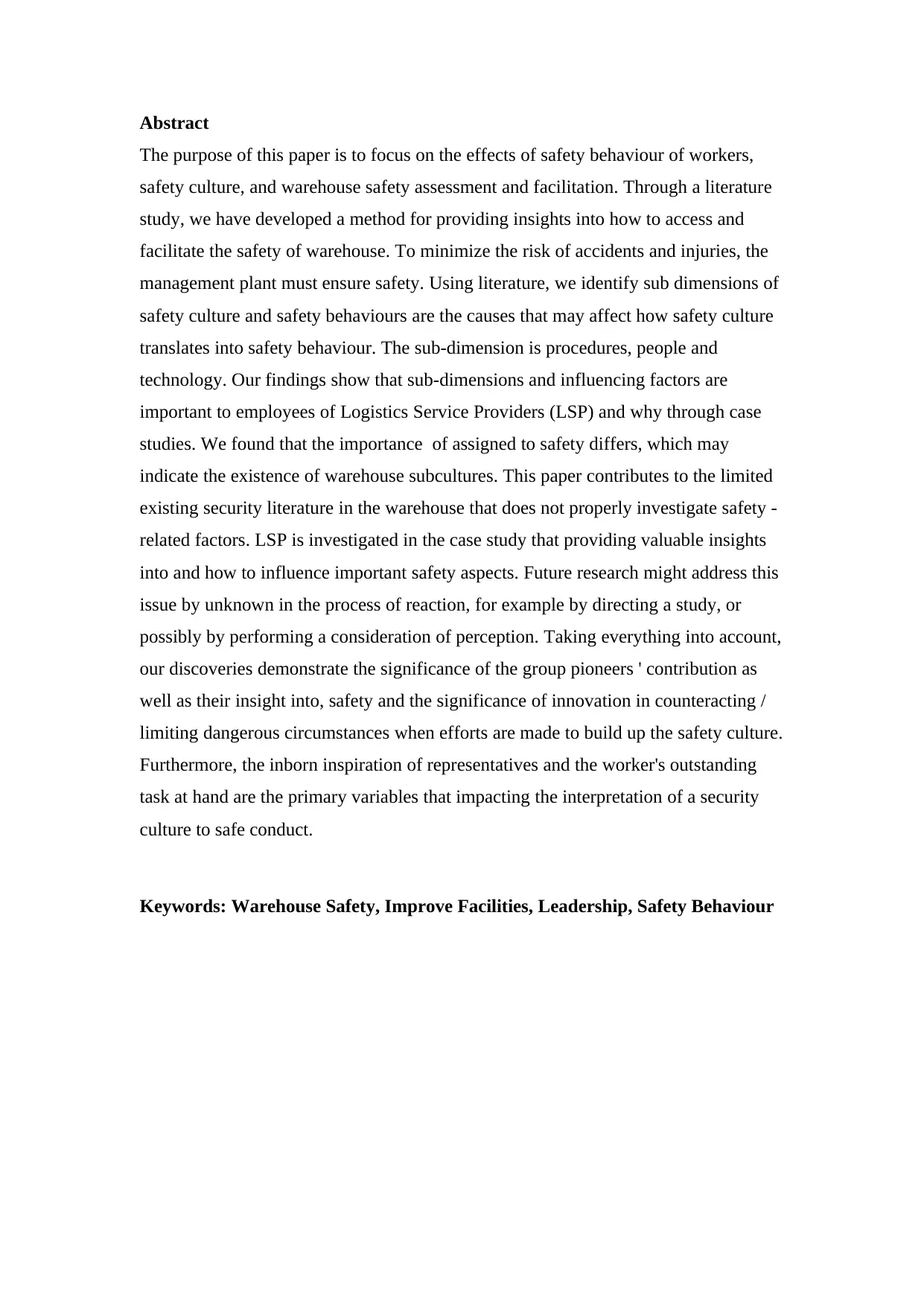
Abstract
The purpose of this paper is to focus on the effects of safety behaviour of workers,
safety culture, and warehouse safety assessment and facilitation. Through a literature
study, we have developed a method for providing insights into how to access and
facilitate the safety of warehouse. To minimize the risk of accidents and injuries, the
management plant must ensure safety. Using literature, we identify sub dimensions of
safety culture and safety behaviours are the causes that may affect how safety culture
translates into safety behaviour. The sub-dimension is procedures, people and
technology. Our findings show that sub-dimensions and influencing factors are
important to employees of Logistics Service Providers (LSP) and why through case
studies. We found that the importance of assigned to safety differs, which may
indicate the existence of warehouse subcultures. This paper contributes to the limited
existing security literature in the warehouse that does not properly investigate safety -
related factors. LSP is investigated in the case study that providing valuable insights
into and how to influence important safety aspects. Future research might address this
issue by unknown in the process of reaction, for example by directing a study, or
possibly by performing a consideration of perception. Taking everything into account,
our discoveries demonstrate the significance of the group pioneers ' contribution as
well as their insight into, safety and the significance of innovation in counteracting /
limiting dangerous circumstances when efforts are made to build up the safety culture.
Furthermore, the inborn inspiration of representatives and the worker's outstanding
task at hand are the primary variables that impacting the interpretation of a security
culture to safe conduct.
Keywords: Warehouse Safety, Improve Facilities, Leadership, Safety Behaviour
The purpose of this paper is to focus on the effects of safety behaviour of workers,
safety culture, and warehouse safety assessment and facilitation. Through a literature
study, we have developed a method for providing insights into how to access and
facilitate the safety of warehouse. To minimize the risk of accidents and injuries, the
management plant must ensure safety. Using literature, we identify sub dimensions of
safety culture and safety behaviours are the causes that may affect how safety culture
translates into safety behaviour. The sub-dimension is procedures, people and
technology. Our findings show that sub-dimensions and influencing factors are
important to employees of Logistics Service Providers (LSP) and why through case
studies. We found that the importance of assigned to safety differs, which may
indicate the existence of warehouse subcultures. This paper contributes to the limited
existing security literature in the warehouse that does not properly investigate safety -
related factors. LSP is investigated in the case study that providing valuable insights
into and how to influence important safety aspects. Future research might address this
issue by unknown in the process of reaction, for example by directing a study, or
possibly by performing a consideration of perception. Taking everything into account,
our discoveries demonstrate the significance of the group pioneers ' contribution as
well as their insight into, safety and the significance of innovation in counteracting /
limiting dangerous circumstances when efforts are made to build up the safety culture.
Furthermore, the inborn inspiration of representatives and the worker's outstanding
task at hand are the primary variables that impacting the interpretation of a security
culture to safe conduct.
Keywords: Warehouse Safety, Improve Facilities, Leadership, Safety Behaviour
Paraphrase This Document
Need a fresh take? Get an instant paraphrase of this document with our AI Paraphraser
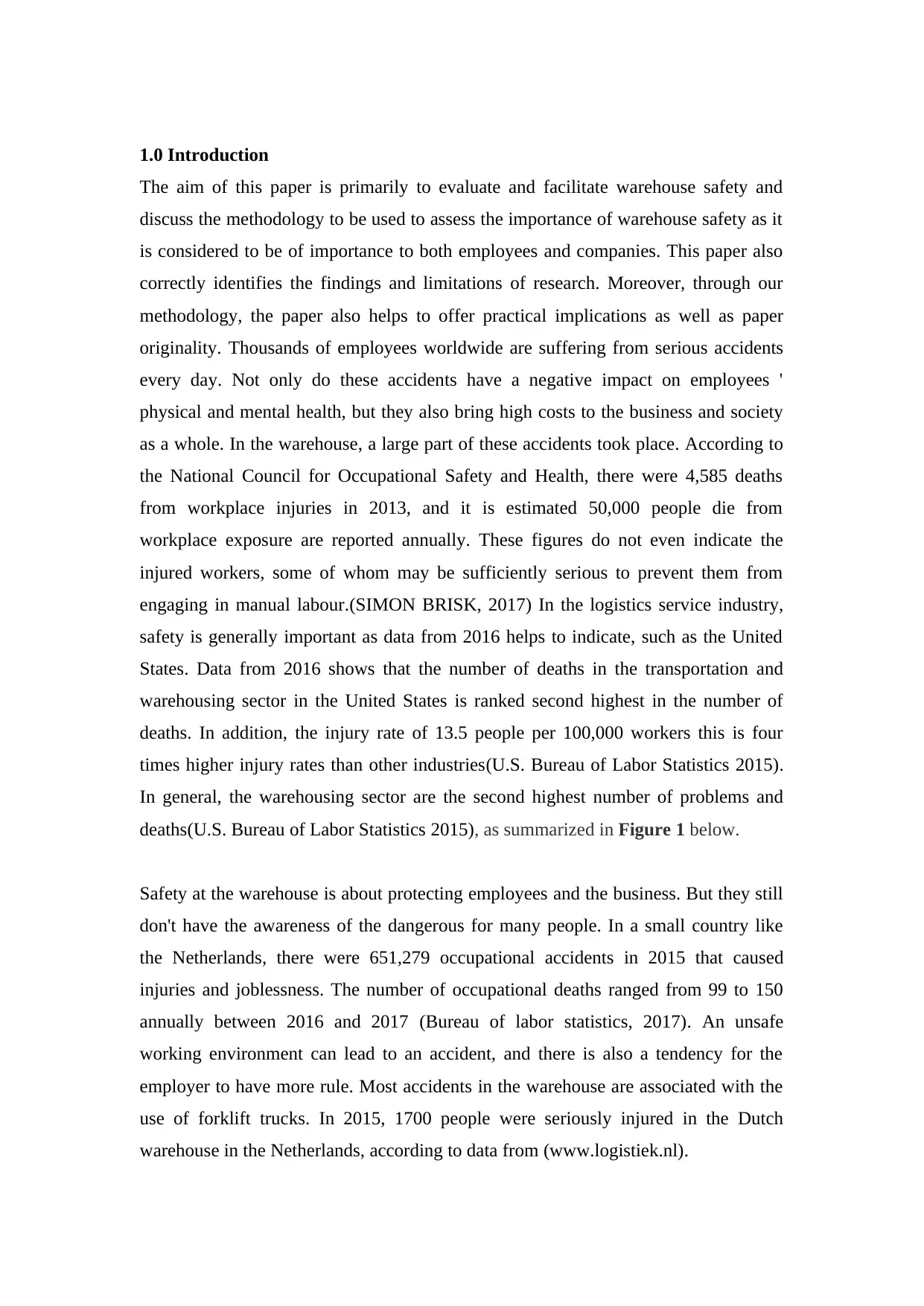
1.0 Introduction
The aim of this paper is primarily to evaluate and facilitate warehouse safety and
discuss the methodology to be used to assess the importance of warehouse safety as it
is considered to be of importance to both employees and companies. This paper also
correctly identifies the findings and limitations of research. Moreover, through our
methodology, the paper also helps to offer practical implications as well as paper
originality. Thousands of employees worldwide are suffering from serious accidents
every day. Not only do these accidents have a negative impact on employees '
physical and mental health, but they also bring high costs to the business and society
as a whole. In the warehouse, a large part of these accidents took place. According to
the National Council for Occupational Safety and Health, there were 4,585 deaths
from workplace injuries in 2013, and it is estimated 50,000 people die from
workplace exposure are reported annually. These figures do not even indicate the
injured workers, some of whom may be sufficiently serious to prevent them from
engaging in manual labour.(SIMON BRISK, 2017) In the logistics service industry,
safety is generally important as data from 2016 helps to indicate, such as the United
States. Data from 2016 shows that the number of deaths in the transportation and
warehousing sector in the United States is ranked second highest in the number of
deaths. In addition, the injury rate of 13.5 people per 100,000 workers this is four
times higher injury rates than other industries(U.S. Bureau of Labor Statistics 2015).
In general, the warehousing sector are the second highest number of problems and
deaths(U.S. Bureau of Labor Statistics 2015), as summarized in Figure 1 below.
Safety at the warehouse is about protecting employees and the business. But they still
don't have the awareness of the dangerous for many people. In a small country like
the Netherlands, there were 651,279 occupational accidents in 2015 that caused
injuries and joblessness. The number of occupational deaths ranged from 99 to 150
annually between 2016 and 2017 (Bureau of labor statistics, 2017). An unsafe
working environment can lead to an accident, and there is also a tendency for the
employer to have more rule. Most accidents in the warehouse are associated with the
use of forklift trucks. In 2015, 1700 people were seriously injured in the Dutch
warehouse in the Netherlands, according to data from (www.logistiek.nl).
The aim of this paper is primarily to evaluate and facilitate warehouse safety and
discuss the methodology to be used to assess the importance of warehouse safety as it
is considered to be of importance to both employees and companies. This paper also
correctly identifies the findings and limitations of research. Moreover, through our
methodology, the paper also helps to offer practical implications as well as paper
originality. Thousands of employees worldwide are suffering from serious accidents
every day. Not only do these accidents have a negative impact on employees '
physical and mental health, but they also bring high costs to the business and society
as a whole. In the warehouse, a large part of these accidents took place. According to
the National Council for Occupational Safety and Health, there were 4,585 deaths
from workplace injuries in 2013, and it is estimated 50,000 people die from
workplace exposure are reported annually. These figures do not even indicate the
injured workers, some of whom may be sufficiently serious to prevent them from
engaging in manual labour.(SIMON BRISK, 2017) In the logistics service industry,
safety is generally important as data from 2016 helps to indicate, such as the United
States. Data from 2016 shows that the number of deaths in the transportation and
warehousing sector in the United States is ranked second highest in the number of
deaths. In addition, the injury rate of 13.5 people per 100,000 workers this is four
times higher injury rates than other industries(U.S. Bureau of Labor Statistics 2015).
In general, the warehousing sector are the second highest number of problems and
deaths(U.S. Bureau of Labor Statistics 2015), as summarized in Figure 1 below.
Safety at the warehouse is about protecting employees and the business. But they still
don't have the awareness of the dangerous for many people. In a small country like
the Netherlands, there were 651,279 occupational accidents in 2015 that caused
injuries and joblessness. The number of occupational deaths ranged from 99 to 150
annually between 2016 and 2017 (Bureau of labor statistics, 2017). An unsafe
working environment can lead to an accident, and there is also a tendency for the
employer to have more rule. Most accidents in the warehouse are associated with the
use of forklift trucks. In 2015, 1700 people were seriously injured in the Dutch
warehouse in the Netherlands, according to data from (www.logistiek.nl).
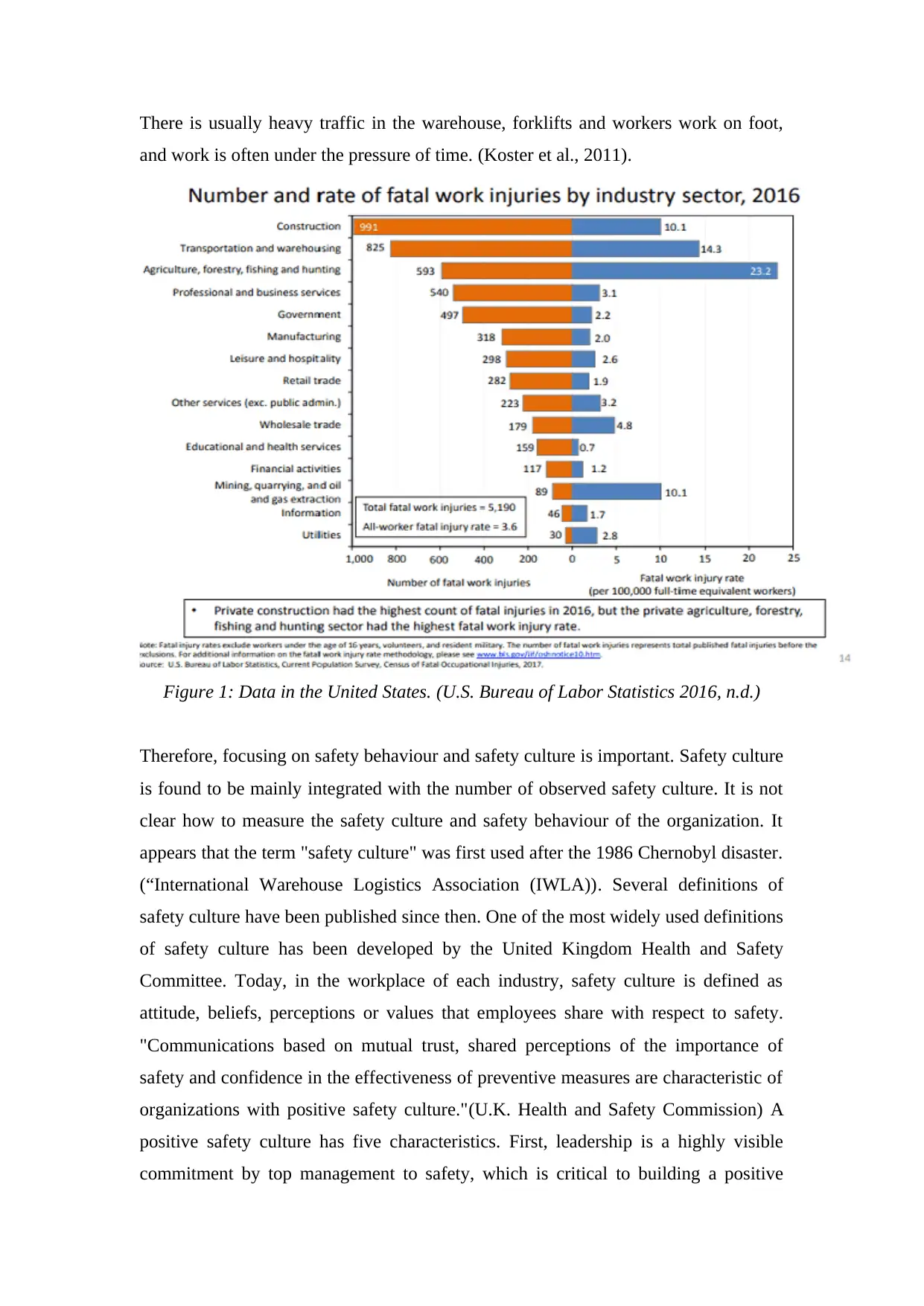
There is usually heavy traffic in the warehouse, forklifts and workers work on foot,
and work is often under the pressure of time. (Koster et al., 2011).
Figure 1: Data in the United States. (U.S. Bureau of Labor Statistics 2016, n.d.)
Therefore, focusing on safety behaviour and safety culture is important. Safety culture
is found to be mainly integrated with the number of observed safety culture. It is not
clear how to measure the safety culture and safety behaviour of the organization. It
appears that the term "safety culture" was first used after the 1986 Chernobyl disaster.
(“International Warehouse Logistics Association (IWLA)). Several definitions of
safety culture have been published since then. One of the most widely used definitions
of safety culture has been developed by the United Kingdom Health and Safety
Committee. Today, in the workplace of each industry, safety culture is defined as
attitude, beliefs, perceptions or values that employees share with respect to safety.
"Communications based on mutual trust, shared perceptions of the importance of
safety and confidence in the effectiveness of preventive measures are characteristic of
organizations with positive safety culture."(U.K. Health and Safety Commission) A
positive safety culture has five characteristics. First, leadership is a highly visible
commitment by top management to safety, which is critical to building a positive
and work is often under the pressure of time. (Koster et al., 2011).
Figure 1: Data in the United States. (U.S. Bureau of Labor Statistics 2016, n.d.)
Therefore, focusing on safety behaviour and safety culture is important. Safety culture
is found to be mainly integrated with the number of observed safety culture. It is not
clear how to measure the safety culture and safety behaviour of the organization. It
appears that the term "safety culture" was first used after the 1986 Chernobyl disaster.
(“International Warehouse Logistics Association (IWLA)). Several definitions of
safety culture have been published since then. One of the most widely used definitions
of safety culture has been developed by the United Kingdom Health and Safety
Committee. Today, in the workplace of each industry, safety culture is defined as
attitude, beliefs, perceptions or values that employees share with respect to safety.
"Communications based on mutual trust, shared perceptions of the importance of
safety and confidence in the effectiveness of preventive measures are characteristic of
organizations with positive safety culture."(U.K. Health and Safety Commission) A
positive safety culture has five characteristics. First, leadership is a highly visible
commitment by top management to safety, which is critical to building a positive
⊘ This is a preview!⊘
Do you want full access?
Subscribe today to unlock all pages.

Trusted by 1+ million students worldwide
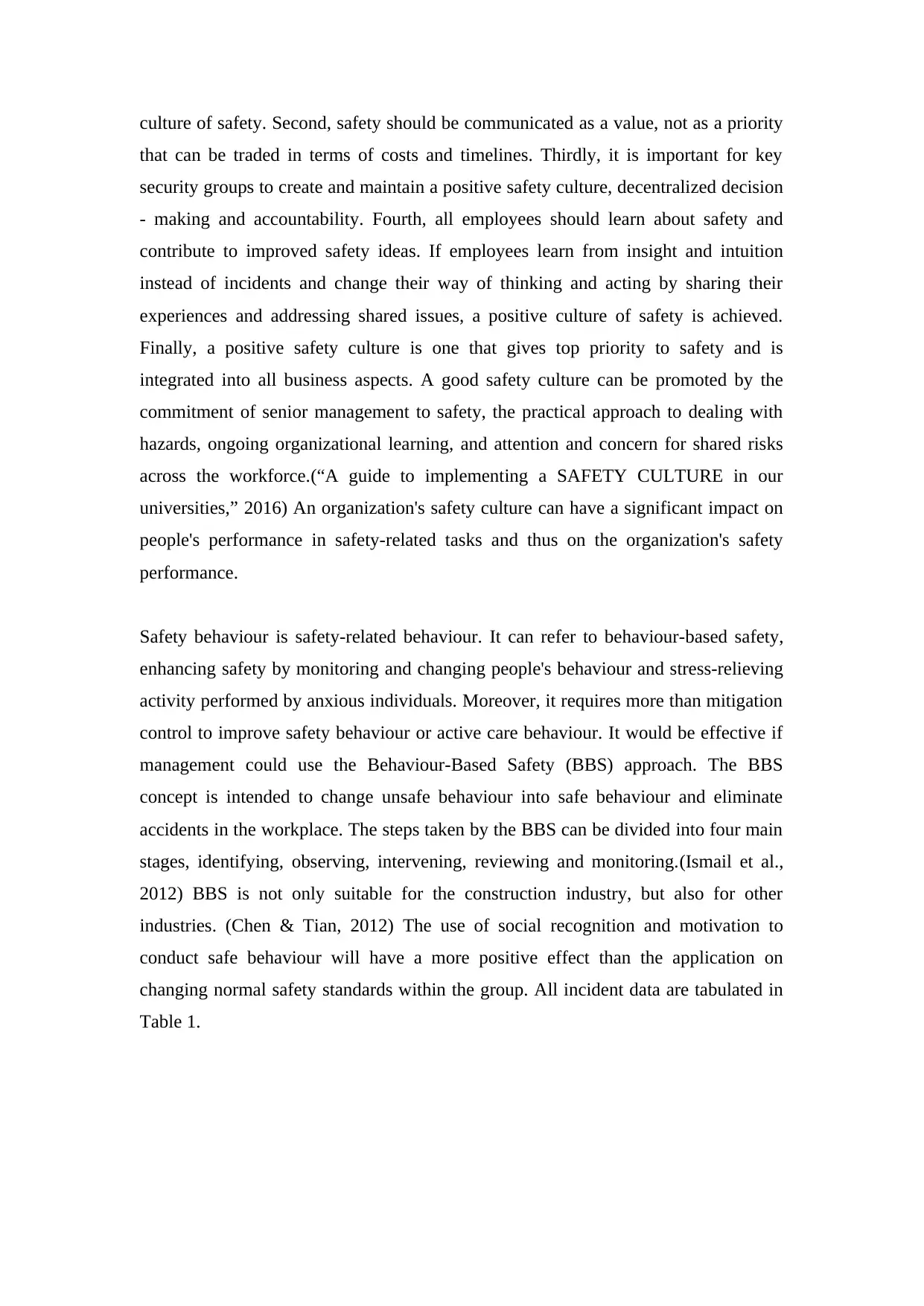
culture of safety. Second, safety should be communicated as a value, not as a priority
that can be traded in terms of costs and timelines. Thirdly, it is important for key
security groups to create and maintain a positive safety culture, decentralized decision
- making and accountability. Fourth, all employees should learn about safety and
contribute to improved safety ideas. If employees learn from insight and intuition
instead of incidents and change their way of thinking and acting by sharing their
experiences and addressing shared issues, a positive culture of safety is achieved.
Finally, a positive safety culture is one that gives top priority to safety and is
integrated into all business aspects. A good safety culture can be promoted by the
commitment of senior management to safety, the practical approach to dealing with
hazards, ongoing organizational learning, and attention and concern for shared risks
across the workforce.(“A guide to implementing a SAFETY CULTURE in our
universities,” 2016) An organization's safety culture can have a significant impact on
people's performance in safety-related tasks and thus on the organization's safety
performance.
Safety behaviour is safety-related behaviour. It can refer to behaviour-based safety,
enhancing safety by monitoring and changing people's behaviour and stress-relieving
activity performed by anxious individuals. Moreover, it requires more than mitigation
control to improve safety behaviour or active care behaviour. It would be effective if
management could use the Behaviour-Based Safety (BBS) approach. The BBS
concept is intended to change unsafe behaviour into safe behaviour and eliminate
accidents in the workplace. The steps taken by the BBS can be divided into four main
stages, identifying, observing, intervening, reviewing and monitoring.(Ismail et al.,
2012) BBS is not only suitable for the construction industry, but also for other
industries. (Chen & Tian, 2012) The use of social recognition and motivation to
conduct safe behaviour will have a more positive effect than the application on
changing normal safety standards within the group. All incident data are tabulated in
Table 1.
that can be traded in terms of costs and timelines. Thirdly, it is important for key
security groups to create and maintain a positive safety culture, decentralized decision
- making and accountability. Fourth, all employees should learn about safety and
contribute to improved safety ideas. If employees learn from insight and intuition
instead of incidents and change their way of thinking and acting by sharing their
experiences and addressing shared issues, a positive culture of safety is achieved.
Finally, a positive safety culture is one that gives top priority to safety and is
integrated into all business aspects. A good safety culture can be promoted by the
commitment of senior management to safety, the practical approach to dealing with
hazards, ongoing organizational learning, and attention and concern for shared risks
across the workforce.(“A guide to implementing a SAFETY CULTURE in our
universities,” 2016) An organization's safety culture can have a significant impact on
people's performance in safety-related tasks and thus on the organization's safety
performance.
Safety behaviour is safety-related behaviour. It can refer to behaviour-based safety,
enhancing safety by monitoring and changing people's behaviour and stress-relieving
activity performed by anxious individuals. Moreover, it requires more than mitigation
control to improve safety behaviour or active care behaviour. It would be effective if
management could use the Behaviour-Based Safety (BBS) approach. The BBS
concept is intended to change unsafe behaviour into safe behaviour and eliminate
accidents in the workplace. The steps taken by the BBS can be divided into four main
stages, identifying, observing, intervening, reviewing and monitoring.(Ismail et al.,
2012) BBS is not only suitable for the construction industry, but also for other
industries. (Chen & Tian, 2012) The use of social recognition and motivation to
conduct safe behaviour will have a more positive effect than the application on
changing normal safety standards within the group. All incident data are tabulated in
Table 1.
Paraphrase This Document
Need a fresh take? Get an instant paraphrase of this document with our AI Paraphraser
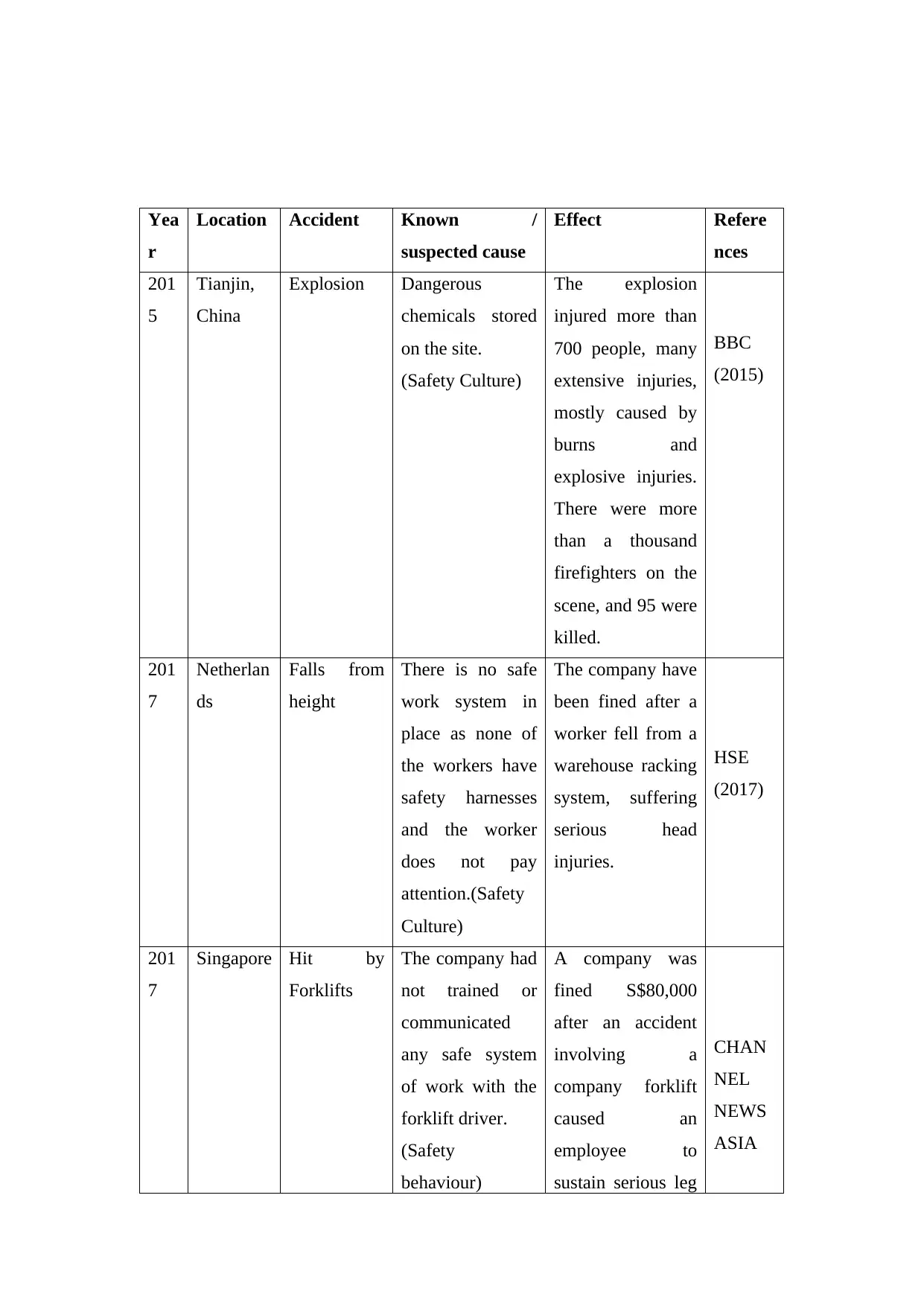
Yea
r
Location Accident Known /
suspected cause
Effect Refere
nces
201
5
Tianjin,
China
Explosion Dangerous
chemicals stored
on the site.
(Safety Culture)
The explosion
injured more than
700 people, many
extensive injuries,
mostly caused by
burns and
explosive injuries.
There were more
than a thousand
firefighters on the
scene, and 95 were
killed.
BBC
(2015)
201
7
Netherlan
ds
Falls from
height
There is no safe
work system in
place as none of
the workers have
safety harnesses
and the worker
does not pay
attention.(Safety
Culture)
The company have
been fined after a
worker fell from a
warehouse racking
system, suffering
serious head
injuries.
HSE
(2017)
201
7
Singapore Hit by
Forklifts
The company had
not trained or
communicated
any safe system
of work with the
forklift driver.
(Safety
behaviour)
A company was
fined S$80,000
after an accident
involving a
company forklift
caused an
employee to
sustain serious leg
CHAN
NEL
NEWS
ASIA
r
Location Accident Known /
suspected cause
Effect Refere
nces
201
5
Tianjin,
China
Explosion Dangerous
chemicals stored
on the site.
(Safety Culture)
The explosion
injured more than
700 people, many
extensive injuries,
mostly caused by
burns and
explosive injuries.
There were more
than a thousand
firefighters on the
scene, and 95 were
killed.
BBC
(2015)
201
7
Netherlan
ds
Falls from
height
There is no safe
work system in
place as none of
the workers have
safety harnesses
and the worker
does not pay
attention.(Safety
Culture)
The company have
been fined after a
worker fell from a
warehouse racking
system, suffering
serious head
injuries.
HSE
(2017)
201
7
Singapore Hit by
Forklifts
The company had
not trained or
communicated
any safe system
of work with the
forklift driver.
(Safety
behaviour)
A company was
fined S$80,000
after an accident
involving a
company forklift
caused an
employee to
sustain serious leg
CHAN
NEL
NEWS
ASIA
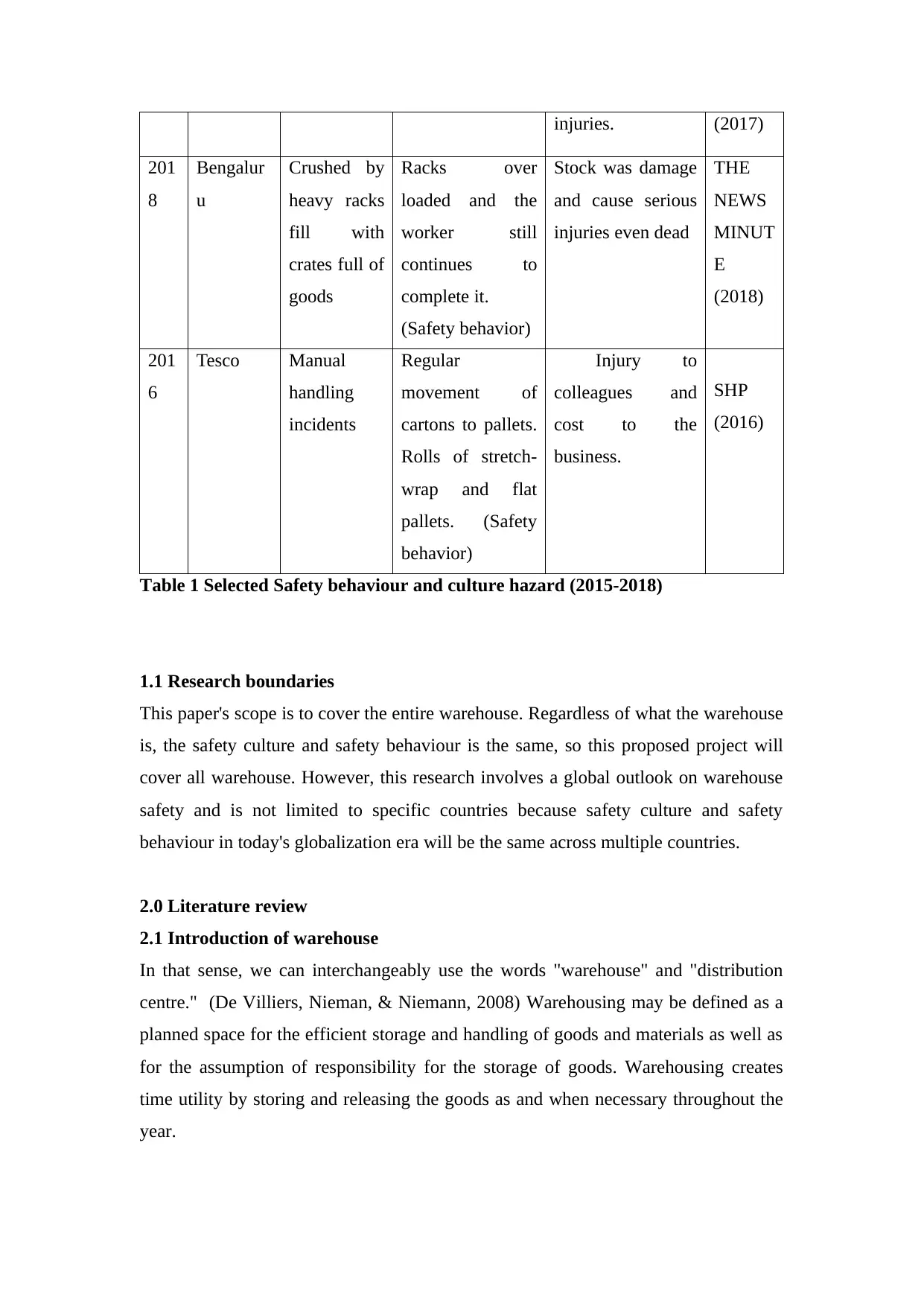
injuries. (2017)
201
8
Bengalur
u
Crushed by
heavy racks
fill with
crates full of
goods
Racks over
loaded and the
worker still
continues to
complete it.
(Safety behavior)
Stock was damage
and cause serious
injuries even dead
THE
NEWS
MINUT
E
(2018)
201
6
Tesco Manual
handling
incidents
Regular
movement of
cartons to pallets.
Rolls of stretch-
wrap and flat
pallets. (Safety
behavior)
Injury to
colleagues and
cost to the
business.
SHP
(2016)
Table 1 Selected Safety behaviour and culture hazard (2015-2018)
1.1 Research boundaries
This paper's scope is to cover the entire warehouse. Regardless of what the warehouse
is, the safety culture and safety behaviour is the same, so this proposed project will
cover all warehouse. However, this research involves a global outlook on warehouse
safety and is not limited to specific countries because safety culture and safety
behaviour in today's globalization era will be the same across multiple countries.
2.0 Literature review
2.1 Introduction of warehouse
In that sense, we can interchangeably use the words "warehouse" and "distribution
centre." (De Villiers, Nieman, & Niemann, 2008) Warehousing may be defined as a
planned space for the efficient storage and handling of goods and materials as well as
for the assumption of responsibility for the storage of goods. Warehousing creates
time utility by storing and releasing the goods as and when necessary throughout the
year.
201
8
Bengalur
u
Crushed by
heavy racks
fill with
crates full of
goods
Racks over
loaded and the
worker still
continues to
complete it.
(Safety behavior)
Stock was damage
and cause serious
injuries even dead
THE
NEWS
MINUT
E
(2018)
201
6
Tesco Manual
handling
incidents
Regular
movement of
cartons to pallets.
Rolls of stretch-
wrap and flat
pallets. (Safety
behavior)
Injury to
colleagues and
cost to the
business.
SHP
(2016)
Table 1 Selected Safety behaviour and culture hazard (2015-2018)
1.1 Research boundaries
This paper's scope is to cover the entire warehouse. Regardless of what the warehouse
is, the safety culture and safety behaviour is the same, so this proposed project will
cover all warehouse. However, this research involves a global outlook on warehouse
safety and is not limited to specific countries because safety culture and safety
behaviour in today's globalization era will be the same across multiple countries.
2.0 Literature review
2.1 Introduction of warehouse
In that sense, we can interchangeably use the words "warehouse" and "distribution
centre." (De Villiers, Nieman, & Niemann, 2008) Warehousing may be defined as a
planned space for the efficient storage and handling of goods and materials as well as
for the assumption of responsibility for the storage of goods. Warehousing creates
time utility by storing and releasing the goods as and when necessary throughout the
year.
⊘ This is a preview!⊘
Do you want full access?
Subscribe today to unlock all pages.

Trusted by 1+ million students worldwide
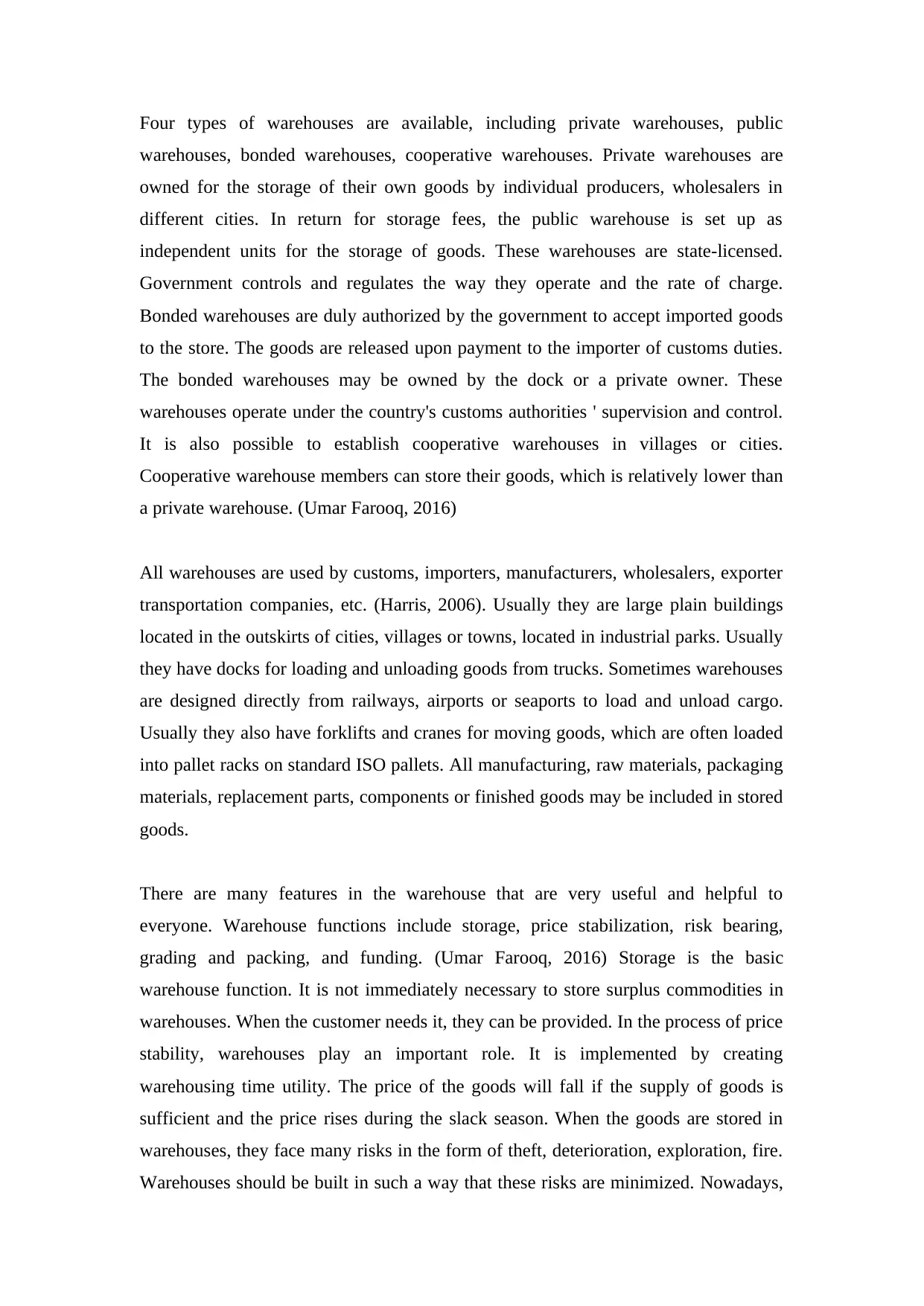
Four types of warehouses are available, including private warehouses, public
warehouses, bonded warehouses, cooperative warehouses. Private warehouses are
owned for the storage of their own goods by individual producers, wholesalers in
different cities. In return for storage fees, the public warehouse is set up as
independent units for the storage of goods. These warehouses are state-licensed.
Government controls and regulates the way they operate and the rate of charge.
Bonded warehouses are duly authorized by the government to accept imported goods
to the store. The goods are released upon payment to the importer of customs duties.
The bonded warehouses may be owned by the dock or a private owner. These
warehouses operate under the country's customs authorities ' supervision and control.
It is also possible to establish cooperative warehouses in villages or cities.
Cooperative warehouse members can store their goods, which is relatively lower than
a private warehouse. (Umar Farooq, 2016)
All warehouses are used by customs, importers, manufacturers, wholesalers, exporter
transportation companies, etc. (Harris, 2006). Usually they are large plain buildings
located in the outskirts of cities, villages or towns, located in industrial parks. Usually
they have docks for loading and unloading goods from trucks. Sometimes warehouses
are designed directly from railways, airports or seaports to load and unload cargo.
Usually they also have forklifts and cranes for moving goods, which are often loaded
into pallet racks on standard ISO pallets. All manufacturing, raw materials, packaging
materials, replacement parts, components or finished goods may be included in stored
goods.
There are many features in the warehouse that are very useful and helpful to
everyone. Warehouse functions include storage, price stabilization, risk bearing,
grading and packing, and funding. (Umar Farooq, 2016) Storage is the basic
warehouse function. It is not immediately necessary to store surplus commodities in
warehouses. When the customer needs it, they can be provided. In the process of price
stability, warehouses play an important role. It is implemented by creating
warehousing time utility. The price of the goods will fall if the supply of goods is
sufficient and the price rises during the slack season. When the goods are stored in
warehouses, they face many risks in the form of theft, deterioration, exploration, fire.
Warehouses should be built in such a way that these risks are minimized. Nowadays,
warehouses, bonded warehouses, cooperative warehouses. Private warehouses are
owned for the storage of their own goods by individual producers, wholesalers in
different cities. In return for storage fees, the public warehouse is set up as
independent units for the storage of goods. These warehouses are state-licensed.
Government controls and regulates the way they operate and the rate of charge.
Bonded warehouses are duly authorized by the government to accept imported goods
to the store. The goods are released upon payment to the importer of customs duties.
The bonded warehouses may be owned by the dock or a private owner. These
warehouses operate under the country's customs authorities ' supervision and control.
It is also possible to establish cooperative warehouses in villages or cities.
Cooperative warehouse members can store their goods, which is relatively lower than
a private warehouse. (Umar Farooq, 2016)
All warehouses are used by customs, importers, manufacturers, wholesalers, exporter
transportation companies, etc. (Harris, 2006). Usually they are large plain buildings
located in the outskirts of cities, villages or towns, located in industrial parks. Usually
they have docks for loading and unloading goods from trucks. Sometimes warehouses
are designed directly from railways, airports or seaports to load and unload cargo.
Usually they also have forklifts and cranes for moving goods, which are often loaded
into pallet racks on standard ISO pallets. All manufacturing, raw materials, packaging
materials, replacement parts, components or finished goods may be included in stored
goods.
There are many features in the warehouse that are very useful and helpful to
everyone. Warehouse functions include storage, price stabilization, risk bearing,
grading and packing, and funding. (Umar Farooq, 2016) Storage is the basic
warehouse function. It is not immediately necessary to store surplus commodities in
warehouses. When the customer needs it, they can be provided. In the process of price
stability, warehouses play an important role. It is implemented by creating
warehousing time utility. The price of the goods will fall if the supply of goods is
sufficient and the price rises during the slack season. When the goods are stored in
warehouses, they face many risks in the form of theft, deterioration, exploration, fire.
Warehouses should be built in such a way that these risks are minimized. Nowadays,
Paraphrase This Document
Need a fresh take? Get an instant paraphrase of this document with our AI Paraphraser
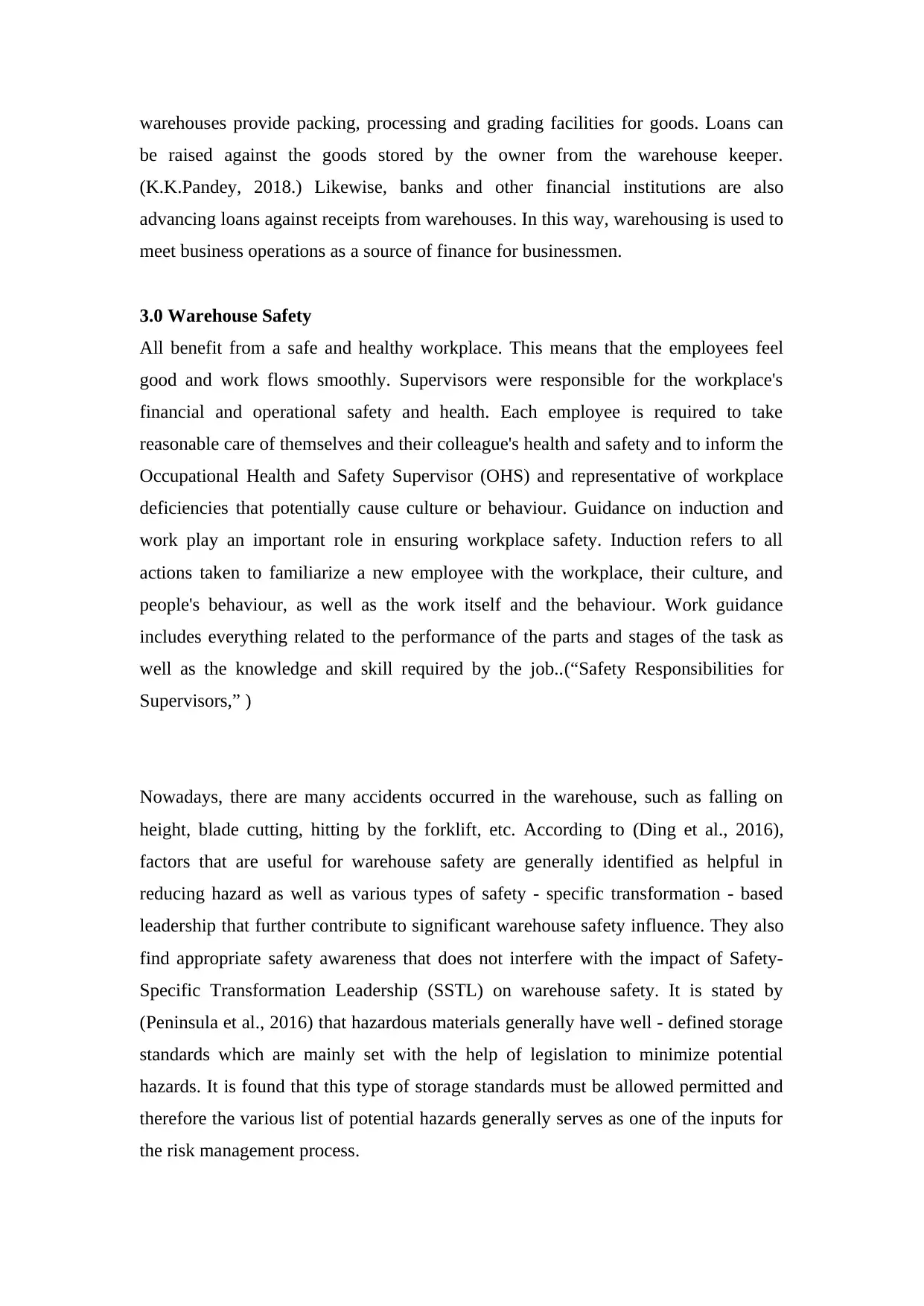
warehouses provide packing, processing and grading facilities for goods. Loans can
be raised against the goods stored by the owner from the warehouse keeper.
(K.K.Pandey, 2018.) Likewise, banks and other financial institutions are also
advancing loans against receipts from warehouses. In this way, warehousing is used to
meet business operations as a source of finance for businessmen.
3.0 Warehouse Safety
All benefit from a safe and healthy workplace. This means that the employees feel
good and work flows smoothly. Supervisors were responsible for the workplace's
financial and operational safety and health. Each employee is required to take
reasonable care of themselves and their colleague's health and safety and to inform the
Occupational Health and Safety Supervisor (OHS) and representative of workplace
deficiencies that potentially cause culture or behaviour. Guidance on induction and
work play an important role in ensuring workplace safety. Induction refers to all
actions taken to familiarize a new employee with the workplace, their culture, and
people's behaviour, as well as the work itself and the behaviour. Work guidance
includes everything related to the performance of the parts and stages of the task as
well as the knowledge and skill required by the job..(“Safety Responsibilities for
Supervisors,” )
Nowadays, there are many accidents occurred in the warehouse, such as falling on
height, blade cutting, hitting by the forklift, etc. According to (Ding et al., 2016),
factors that are useful for warehouse safety are generally identified as helpful in
reducing hazard as well as various types of safety - specific transformation - based
leadership that further contribute to significant warehouse safety influence. They also
find appropriate safety awareness that does not interfere with the impact of Safety-
Specific Transformation Leadership (SSTL) on warehouse safety. It is stated by
(Peninsula et al., 2016) that hazardous materials generally have well - defined storage
standards which are mainly set with the help of legislation to minimize potential
hazards. It is found that this type of storage standards must be allowed permitted and
therefore the various list of potential hazards generally serves as one of the inputs for
the risk management process.
be raised against the goods stored by the owner from the warehouse keeper.
(K.K.Pandey, 2018.) Likewise, banks and other financial institutions are also
advancing loans against receipts from warehouses. In this way, warehousing is used to
meet business operations as a source of finance for businessmen.
3.0 Warehouse Safety
All benefit from a safe and healthy workplace. This means that the employees feel
good and work flows smoothly. Supervisors were responsible for the workplace's
financial and operational safety and health. Each employee is required to take
reasonable care of themselves and their colleague's health and safety and to inform the
Occupational Health and Safety Supervisor (OHS) and representative of workplace
deficiencies that potentially cause culture or behaviour. Guidance on induction and
work play an important role in ensuring workplace safety. Induction refers to all
actions taken to familiarize a new employee with the workplace, their culture, and
people's behaviour, as well as the work itself and the behaviour. Work guidance
includes everything related to the performance of the parts and stages of the task as
well as the knowledge and skill required by the job..(“Safety Responsibilities for
Supervisors,” )
Nowadays, there are many accidents occurred in the warehouse, such as falling on
height, blade cutting, hitting by the forklift, etc. According to (Ding et al., 2016),
factors that are useful for warehouse safety are generally identified as helpful in
reducing hazard as well as various types of safety - specific transformation - based
leadership that further contribute to significant warehouse safety influence. They also
find appropriate safety awareness that does not interfere with the impact of Safety-
Specific Transformation Leadership (SSTL) on warehouse safety. It is stated by
(Peninsula et al., 2016) that hazardous materials generally have well - defined storage
standards which are mainly set with the help of legislation to minimize potential
hazards. It is found that this type of storage standards must be allowed permitted and
therefore the various list of potential hazards generally serves as one of the inputs for
the risk management process.
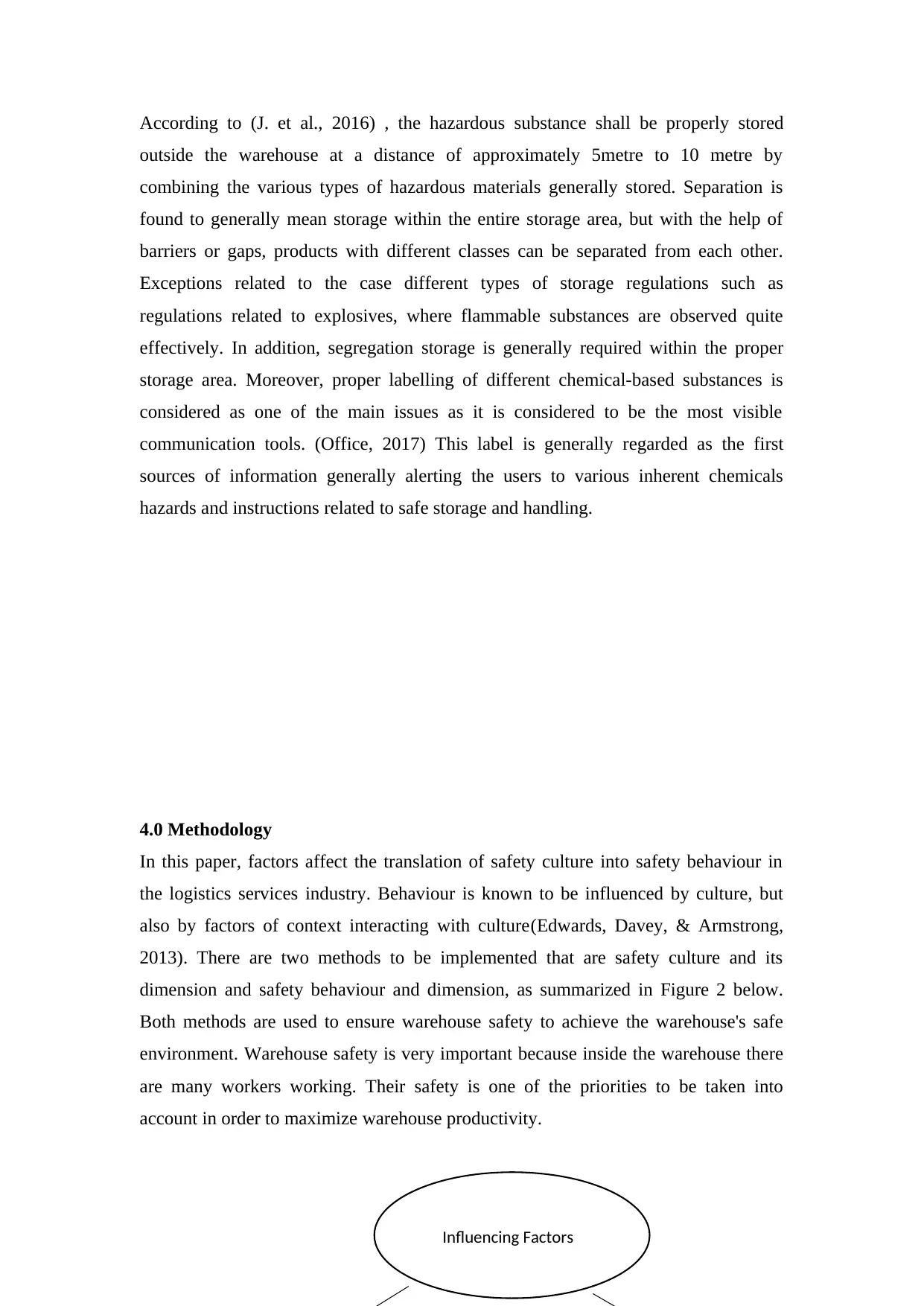
According to (J. et al., 2016) , the hazardous substance shall be properly stored
outside the warehouse at a distance of approximately 5metre to 10 metre by
combining the various types of hazardous materials generally stored. Separation is
found to generally mean storage within the entire storage area, but with the help of
barriers or gaps, products with different classes can be separated from each other.
Exceptions related to the case different types of storage regulations such as
regulations related to explosives, where flammable substances are observed quite
effectively. In addition, segregation storage is generally required within the proper
storage area. Moreover, proper labelling of different chemical-based substances is
considered as one of the main issues as it is considered to be the most visible
communication tools. (Office, 2017) This label is generally regarded as the first
sources of information generally alerting the users to various inherent chemicals
hazards and instructions related to safe storage and handling.
4.0 Methodology
In this paper, factors affect the translation of safety culture into safety behaviour in
the logistics services industry. Behaviour is known to be influenced by culture, but
also by factors of context interacting with culture(Edwards, Davey, & Armstrong,
2013). There are two methods to be implemented that are safety culture and its
dimension and safety behaviour and dimension, as summarized in Figure 2 below.
Both methods are used to ensure warehouse safety to achieve the warehouse's safe
environment. Warehouse safety is very important because inside the warehouse there
are many workers working. Their safety is one of the priorities to be taken into
account in order to maximize warehouse productivity.
Influencing Factors
outside the warehouse at a distance of approximately 5metre to 10 metre by
combining the various types of hazardous materials generally stored. Separation is
found to generally mean storage within the entire storage area, but with the help of
barriers or gaps, products with different classes can be separated from each other.
Exceptions related to the case different types of storage regulations such as
regulations related to explosives, where flammable substances are observed quite
effectively. In addition, segregation storage is generally required within the proper
storage area. Moreover, proper labelling of different chemical-based substances is
considered as one of the main issues as it is considered to be the most visible
communication tools. (Office, 2017) This label is generally regarded as the first
sources of information generally alerting the users to various inherent chemicals
hazards and instructions related to safe storage and handling.
4.0 Methodology
In this paper, factors affect the translation of safety culture into safety behaviour in
the logistics services industry. Behaviour is known to be influenced by culture, but
also by factors of context interacting with culture(Edwards, Davey, & Armstrong,
2013). There are two methods to be implemented that are safety culture and its
dimension and safety behaviour and dimension, as summarized in Figure 2 below.
Both methods are used to ensure warehouse safety to achieve the warehouse's safe
environment. Warehouse safety is very important because inside the warehouse there
are many workers working. Their safety is one of the priorities to be taken into
account in order to maximize warehouse productivity.
Influencing Factors
⊘ This is a preview!⊘
Do you want full access?
Subscribe today to unlock all pages.

Trusted by 1+ million students worldwide
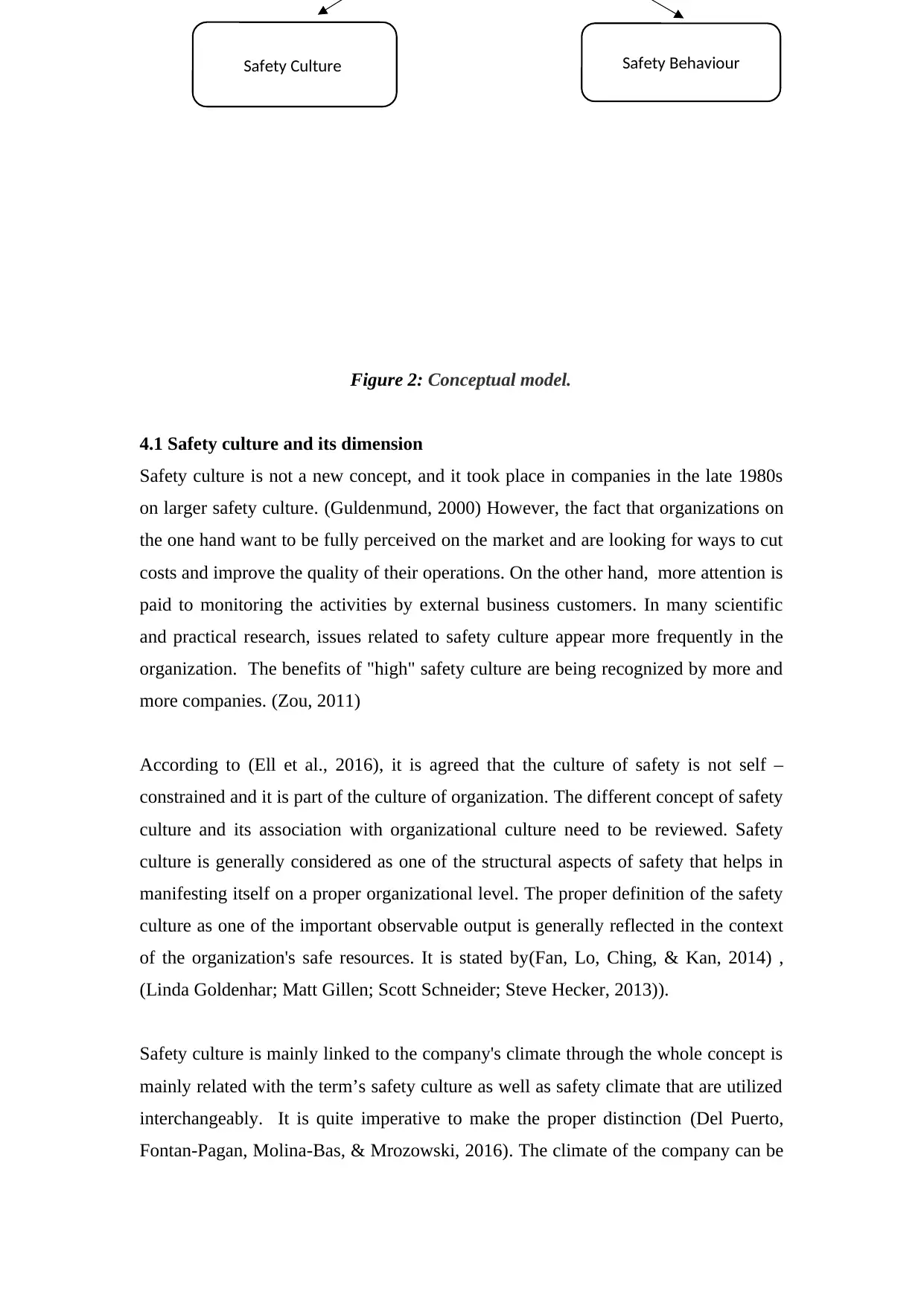
Figure 2: Conceptual model.
4.1 Safety culture and its dimension
Safety culture is not a new concept, and it took place in companies in the late 1980s
on larger safety culture. (Guldenmund, 2000) However, the fact that organizations on
the one hand want to be fully perceived on the market and are looking for ways to cut
costs and improve the quality of their operations. On the other hand, more attention is
paid to monitoring the activities by external business customers. In many scientific
and practical research, issues related to safety culture appear more frequently in the
organization. The benefits of "high" safety culture are being recognized by more and
more companies. (Zou, 2011)
According to (Ell et al., 2016), it is agreed that the culture of safety is not self –
constrained and it is part of the culture of organization. The different concept of safety
culture and its association with organizational culture need to be reviewed. Safety
culture is generally considered as one of the structural aspects of safety that helps in
manifesting itself on a proper organizational level. The proper definition of the safety
culture as one of the important observable output is generally reflected in the context
of the organization's safe resources. It is stated by(Fan, Lo, Ching, & Kan, 2014) ,
(Linda Goldenhar; Matt Gillen; Scott Schneider; Steve Hecker, 2013)).
Safety culture is mainly linked to the company's climate through the whole concept is
mainly related with the term’s safety culture as well as safety climate that are utilized
interchangeably. It is quite imperative to make the proper distinction (Del Puerto,
Fontan-Pagan, Molina-Bas, & Mrozowski, 2016). The climate of the company can be
Safety Culture Safety Behaviour
4.1 Safety culture and its dimension
Safety culture is not a new concept, and it took place in companies in the late 1980s
on larger safety culture. (Guldenmund, 2000) However, the fact that organizations on
the one hand want to be fully perceived on the market and are looking for ways to cut
costs and improve the quality of their operations. On the other hand, more attention is
paid to monitoring the activities by external business customers. In many scientific
and practical research, issues related to safety culture appear more frequently in the
organization. The benefits of "high" safety culture are being recognized by more and
more companies. (Zou, 2011)
According to (Ell et al., 2016), it is agreed that the culture of safety is not self –
constrained and it is part of the culture of organization. The different concept of safety
culture and its association with organizational culture need to be reviewed. Safety
culture is generally considered as one of the structural aspects of safety that helps in
manifesting itself on a proper organizational level. The proper definition of the safety
culture as one of the important observable output is generally reflected in the context
of the organization's safe resources. It is stated by(Fan, Lo, Ching, & Kan, 2014) ,
(Linda Goldenhar; Matt Gillen; Scott Schneider; Steve Hecker, 2013)).
Safety culture is mainly linked to the company's climate through the whole concept is
mainly related with the term’s safety culture as well as safety climate that are utilized
interchangeably. It is quite imperative to make the proper distinction (Del Puerto,
Fontan-Pagan, Molina-Bas, & Mrozowski, 2016). The climate of the company can be
Safety Culture Safety Behaviour
Paraphrase This Document
Need a fresh take? Get an instant paraphrase of this document with our AI Paraphraser
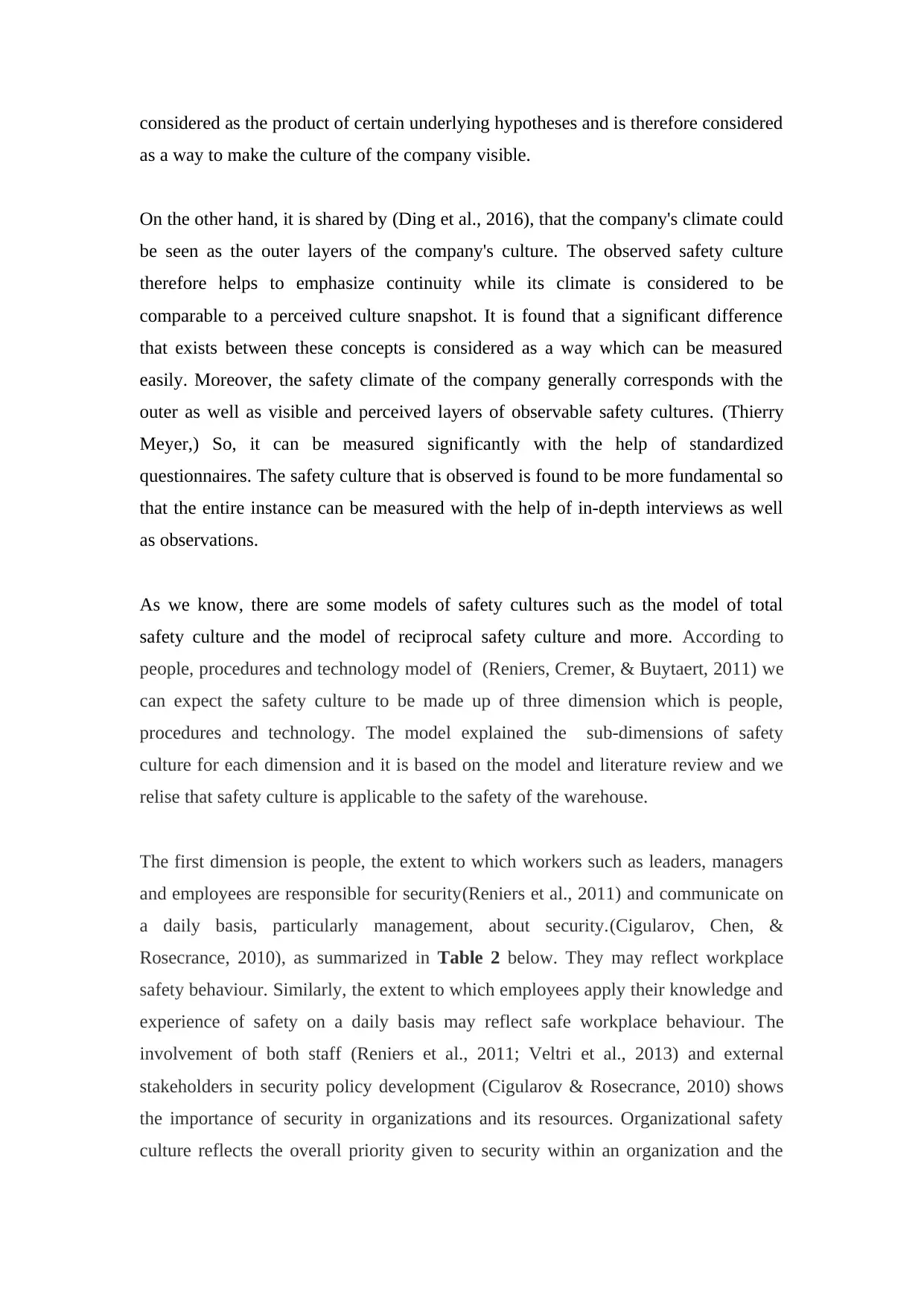
considered as the product of certain underlying hypotheses and is therefore considered
as a way to make the culture of the company visible.
On the other hand, it is shared by (Ding et al., 2016), that the company's climate could
be seen as the outer layers of the company's culture. The observed safety culture
therefore helps to emphasize continuity while its climate is considered to be
comparable to a perceived culture snapshot. It is found that a significant difference
that exists between these concepts is considered as a way which can be measured
easily. Moreover, the safety climate of the company generally corresponds with the
outer as well as visible and perceived layers of observable safety cultures. (Thierry
Meyer,) So, it can be measured significantly with the help of standardized
questionnaires. The safety culture that is observed is found to be more fundamental so
that the entire instance can be measured with the help of in-depth interviews as well
as observations.
As we know, there are some models of safety cultures such as the model of total
safety culture and the model of reciprocal safety culture and more. According to
people, procedures and technology model of (Reniers, Cremer, & Buytaert, 2011) we
can expect the safety culture to be made up of three dimension which is people,
procedures and technology. The model explained the sub-dimensions of safety
culture for each dimension and it is based on the model and literature review and we
relise that safety culture is applicable to the safety of the warehouse.
The first dimension is people, the extent to which workers such as leaders, managers
and employees are responsible for security(Reniers et al., 2011) and communicate on
a daily basis, particularly management, about security.(Cigularov, Chen, &
Rosecrance, 2010), as summarized in Table 2 below. They may reflect workplace
safety behaviour. Similarly, the extent to which employees apply their knowledge and
experience of safety on a daily basis may reflect safe workplace behaviour. The
involvement of both staff (Reniers et al., 2011; Veltri et al., 2013) and external
stakeholders in security policy development (Cigularov & Rosecrance, 2010) shows
the importance of security in organizations and its resources. Organizational safety
culture reflects the overall priority given to security within an organization and the
as a way to make the culture of the company visible.
On the other hand, it is shared by (Ding et al., 2016), that the company's climate could
be seen as the outer layers of the company's culture. The observed safety culture
therefore helps to emphasize continuity while its climate is considered to be
comparable to a perceived culture snapshot. It is found that a significant difference
that exists between these concepts is considered as a way which can be measured
easily. Moreover, the safety climate of the company generally corresponds with the
outer as well as visible and perceived layers of observable safety cultures. (Thierry
Meyer,) So, it can be measured significantly with the help of standardized
questionnaires. The safety culture that is observed is found to be more fundamental so
that the entire instance can be measured with the help of in-depth interviews as well
as observations.
As we know, there are some models of safety cultures such as the model of total
safety culture and the model of reciprocal safety culture and more. According to
people, procedures and technology model of (Reniers, Cremer, & Buytaert, 2011) we
can expect the safety culture to be made up of three dimension which is people,
procedures and technology. The model explained the sub-dimensions of safety
culture for each dimension and it is based on the model and literature review and we
relise that safety culture is applicable to the safety of the warehouse.
The first dimension is people, the extent to which workers such as leaders, managers
and employees are responsible for security(Reniers et al., 2011) and communicate on
a daily basis, particularly management, about security.(Cigularov, Chen, &
Rosecrance, 2010), as summarized in Table 2 below. They may reflect workplace
safety behaviour. Similarly, the extent to which employees apply their knowledge and
experience of safety on a daily basis may reflect safe workplace behaviour. The
involvement of both staff (Reniers et al., 2011; Veltri et al., 2013) and external
stakeholders in security policy development (Cigularov & Rosecrance, 2010) shows
the importance of security in organizations and its resources. Organizational safety
culture reflects the overall priority given to security within an organization and the
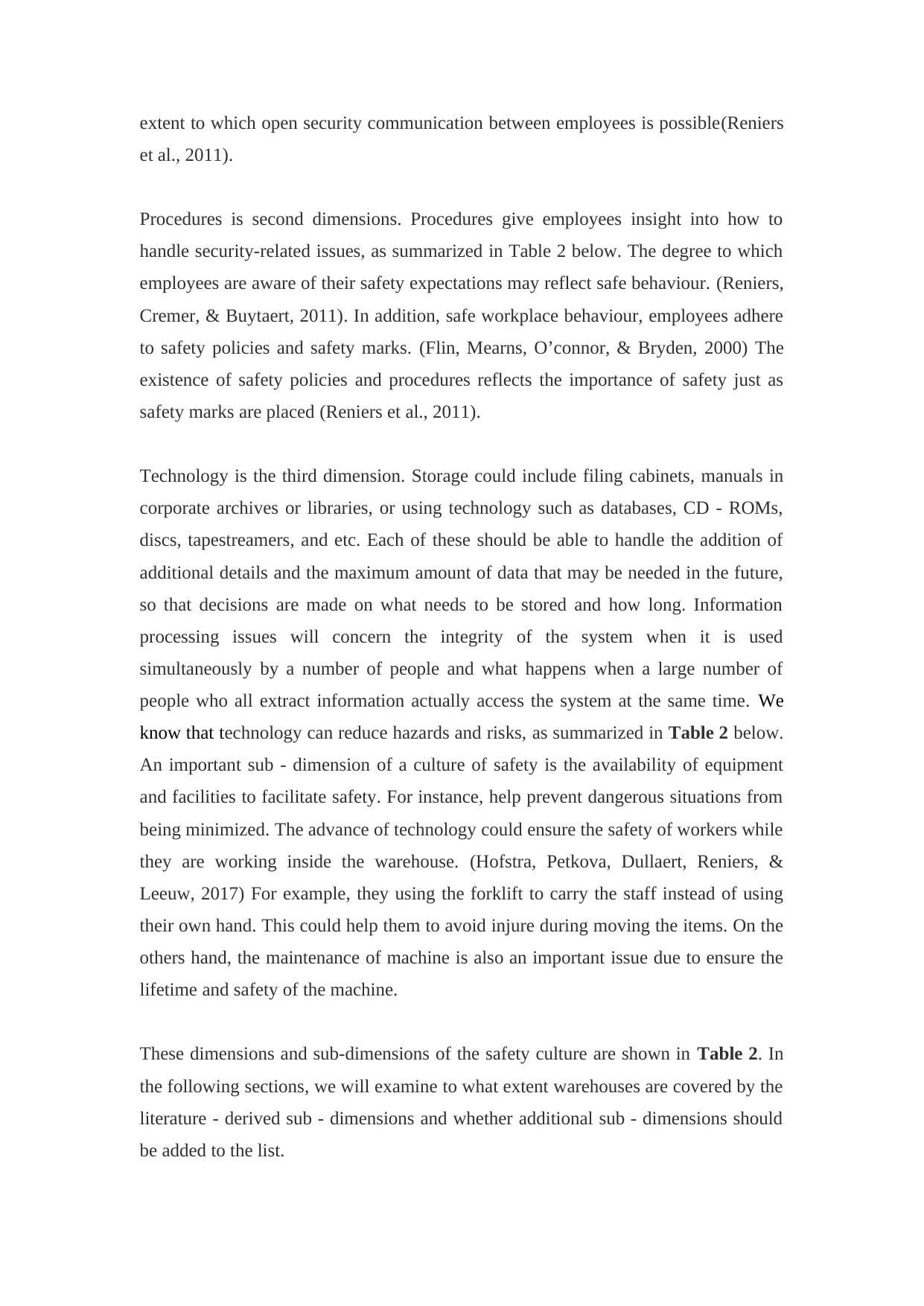
extent to which open security communication between employees is possible(Reniers
et al., 2011).
Procedures is second dimensions. Procedures give employees insight into how to
handle security-related issues, as summarized in Table 2 below. The degree to which
employees are aware of their safety expectations may reflect safe behaviour. (Reniers,
Cremer, & Buytaert, 2011). In addition, safe workplace behaviour, employees adhere
to safety policies and safety marks. (Flin, Mearns, O’connor, & Bryden, 2000) The
existence of safety policies and procedures reflects the importance of safety just as
safety marks are placed (Reniers et al., 2011).
Technology is the third dimension. Storage could include filing cabinets, manuals in
corporate archives or libraries, or using technology such as databases, CD - ROMs,
discs, tapestreamers, and etc. Each of these should be able to handle the addition of
additional details and the maximum amount of data that may be needed in the future,
so that decisions are made on what needs to be stored and how long. Information
processing issues will concern the integrity of the system when it is used
simultaneously by a number of people and what happens when a large number of
people who all extract information actually access the system at the same time. We
know that technology can reduce hazards and risks, as summarized in Table 2 below.
An important sub - dimension of a culture of safety is the availability of equipment
and facilities to facilitate safety. For instance, help prevent dangerous situations from
being minimized. The advance of technology could ensure the safety of workers while
they are working inside the warehouse. (Hofstra, Petkova, Dullaert, Reniers, &
Leeuw, 2017) For example, they using the forklift to carry the staff instead of using
their own hand. This could help them to avoid injure during moving the items. On the
others hand, the maintenance of machine is also an important issue due to ensure the
lifetime and safety of the machine.
These dimensions and sub-dimensions of the safety culture are shown in Table 2. In
the following sections, we will examine to what extent warehouses are covered by the
literature - derived sub - dimensions and whether additional sub - dimensions should
be added to the list.
et al., 2011).
Procedures is second dimensions. Procedures give employees insight into how to
handle security-related issues, as summarized in Table 2 below. The degree to which
employees are aware of their safety expectations may reflect safe behaviour. (Reniers,
Cremer, & Buytaert, 2011). In addition, safe workplace behaviour, employees adhere
to safety policies and safety marks. (Flin, Mearns, O’connor, & Bryden, 2000) The
existence of safety policies and procedures reflects the importance of safety just as
safety marks are placed (Reniers et al., 2011).
Technology is the third dimension. Storage could include filing cabinets, manuals in
corporate archives or libraries, or using technology such as databases, CD - ROMs,
discs, tapestreamers, and etc. Each of these should be able to handle the addition of
additional details and the maximum amount of data that may be needed in the future,
so that decisions are made on what needs to be stored and how long. Information
processing issues will concern the integrity of the system when it is used
simultaneously by a number of people and what happens when a large number of
people who all extract information actually access the system at the same time. We
know that technology can reduce hazards and risks, as summarized in Table 2 below.
An important sub - dimension of a culture of safety is the availability of equipment
and facilities to facilitate safety. For instance, help prevent dangerous situations from
being minimized. The advance of technology could ensure the safety of workers while
they are working inside the warehouse. (Hofstra, Petkova, Dullaert, Reniers, &
Leeuw, 2017) For example, they using the forklift to carry the staff instead of using
their own hand. This could help them to avoid injure during moving the items. On the
others hand, the maintenance of machine is also an important issue due to ensure the
lifetime and safety of the machine.
These dimensions and sub-dimensions of the safety culture are shown in Table 2. In
the following sections, we will examine to what extent warehouses are covered by the
literature - derived sub - dimensions and whether additional sub - dimensions should
be added to the list.
⊘ This is a preview!⊘
Do you want full access?
Subscribe today to unlock all pages.

Trusted by 1+ million students worldwide
1 out of 28
Related Documents
Your All-in-One AI-Powered Toolkit for Academic Success.
+13062052269
info@desklib.com
Available 24*7 on WhatsApp / Email
![[object Object]](/_next/static/media/star-bottom.7253800d.svg)
Unlock your academic potential
Copyright © 2020–2025 A2Z Services. All Rights Reserved. Developed and managed by ZUCOL.





